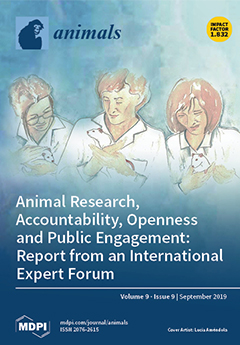Although many byproducts of milling industries have potential as a ruminant feed, they have not been widely used due to their low nutritive value, especially high-fiber content and difficult processing techniques. Steam explosion can increase the degradation of hemicellulose, cellulose and lignin and
[...] Read more.
Although many byproducts of milling industries have potential as a ruminant feed, they have not been widely used due to their low nutritive value, especially high-fiber content and difficult processing techniques. Steam explosion can increase the degradation of hemicellulose, cellulose and lignin and make byproduct feedstuffs more suitable as ruminant feed. Five byproduct feedstuffs: cassava alcohol residue (CAR), distillers’ grains (DG), cottonseed meal (CM), rapeseed meal (RM) and potato starchy residues (PSR), were steam-exploded using five different processing parameters and the effects on the chemical composition,
in vitro digestibility, energy value, and Cornell Net Carbohydrate and Protein System composition were assessed in order to provide a theoretical basis for the technique’s development and utilization for ruminant feed production. In this study, after steam-explosion treatment, the nutritive value and
in vitro dry matter digestibility (IVDMD) of CAR, DG, RM and PSR were improved (
p < 0.05), while there was no effect on nutritive value of CM (
p > 0.05). Specifically, steam explosion treatment decreased the contents of neutral detergent fiber, acid detergent fiber, available cell wall, and slowly degraded protein, and increased the total digestible nutrients, digestible energy, metabolic energy, net energy for maintenance, and net energy for gain, sugar, non-structural carbohydrate and IVDMD. Therefore, steam-explosion treatment offers the potential to improve the suitability of byproduct feedstuffs as ruminant feed.
Full article






